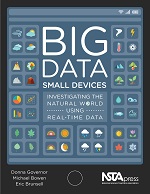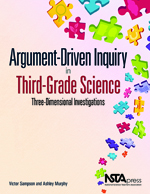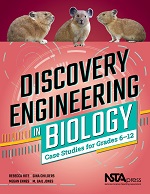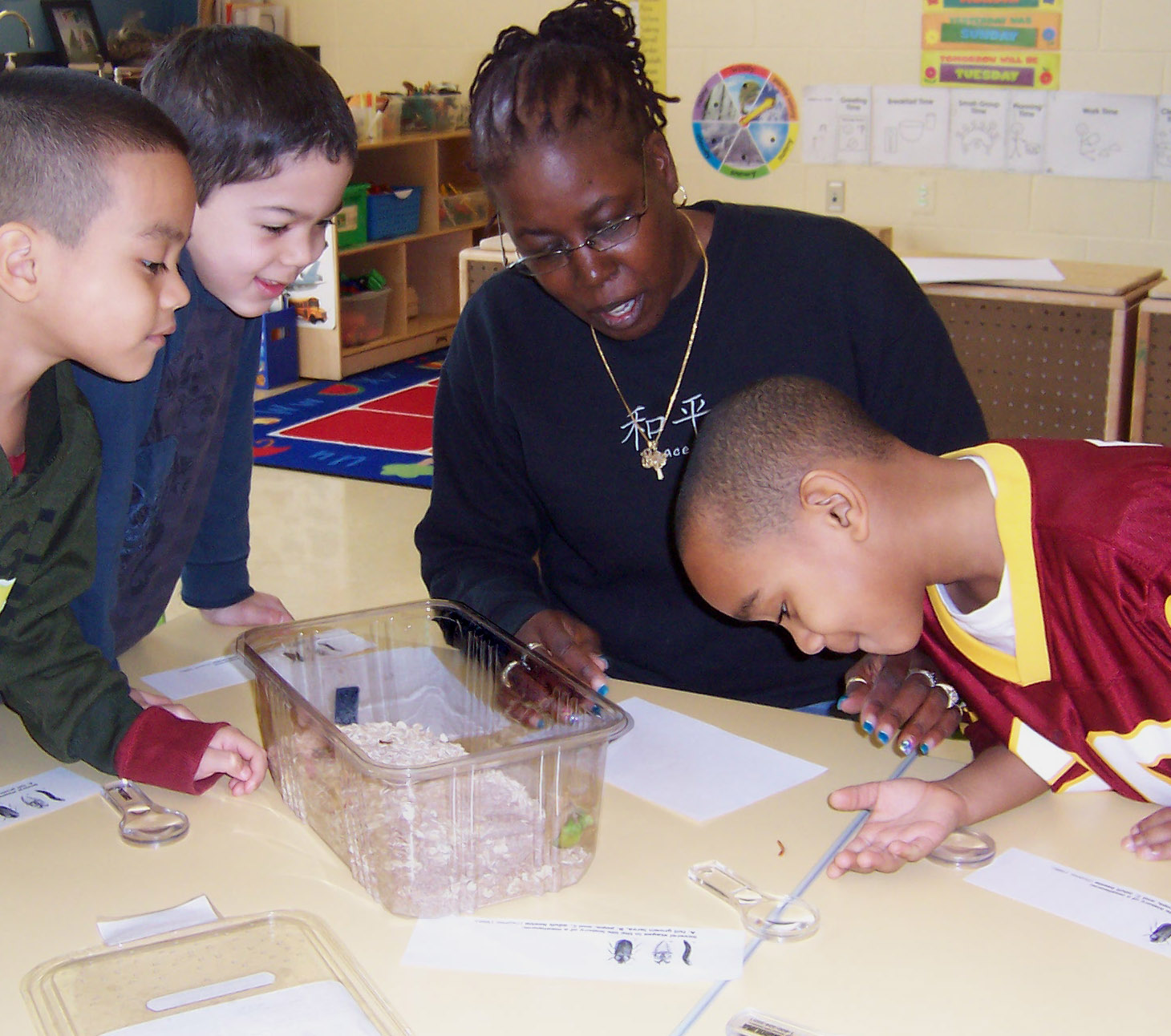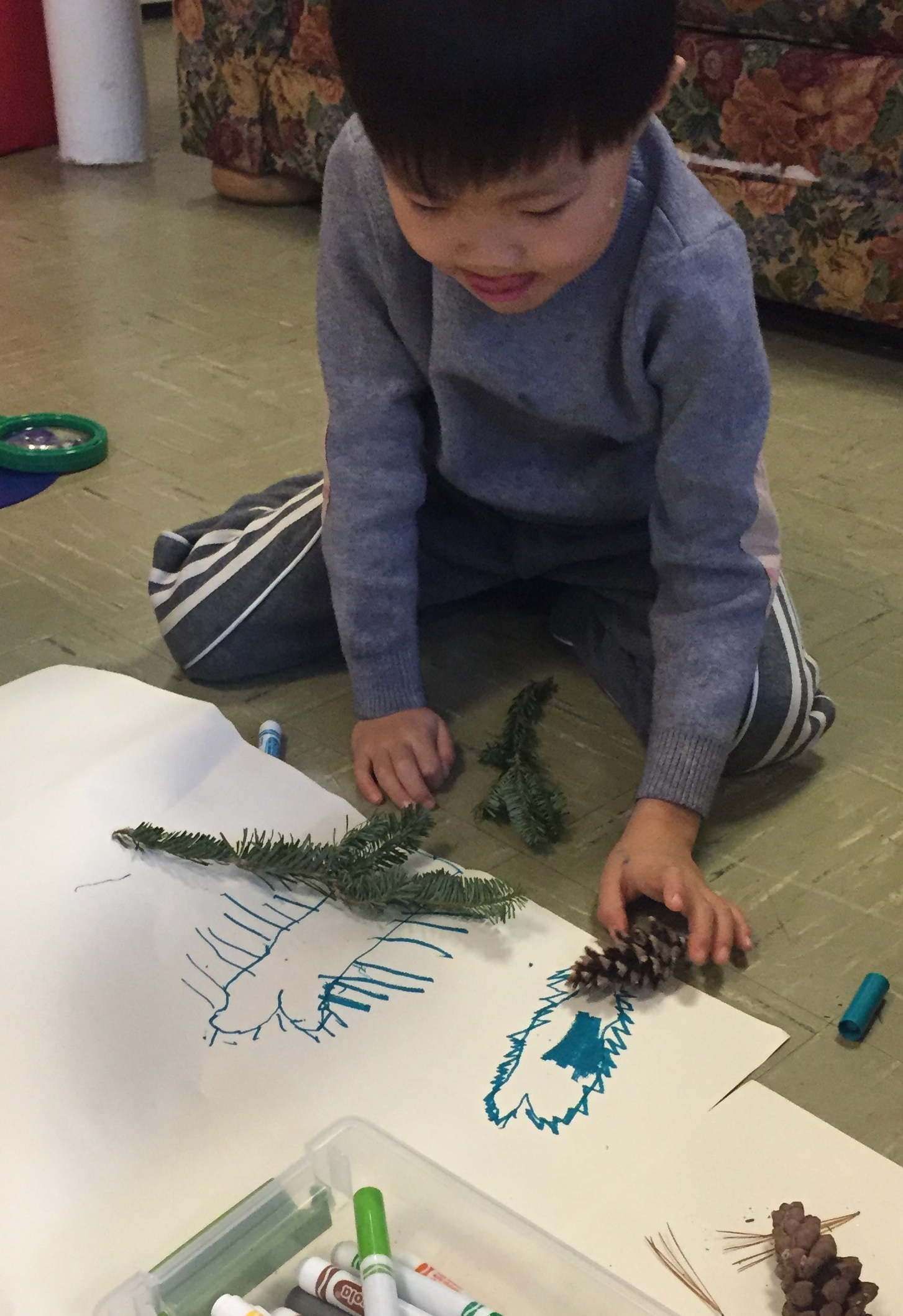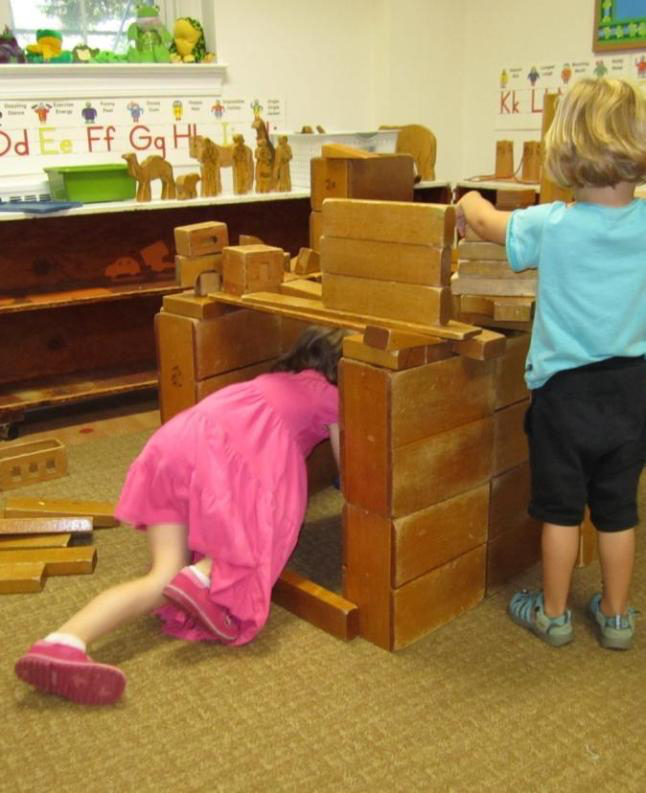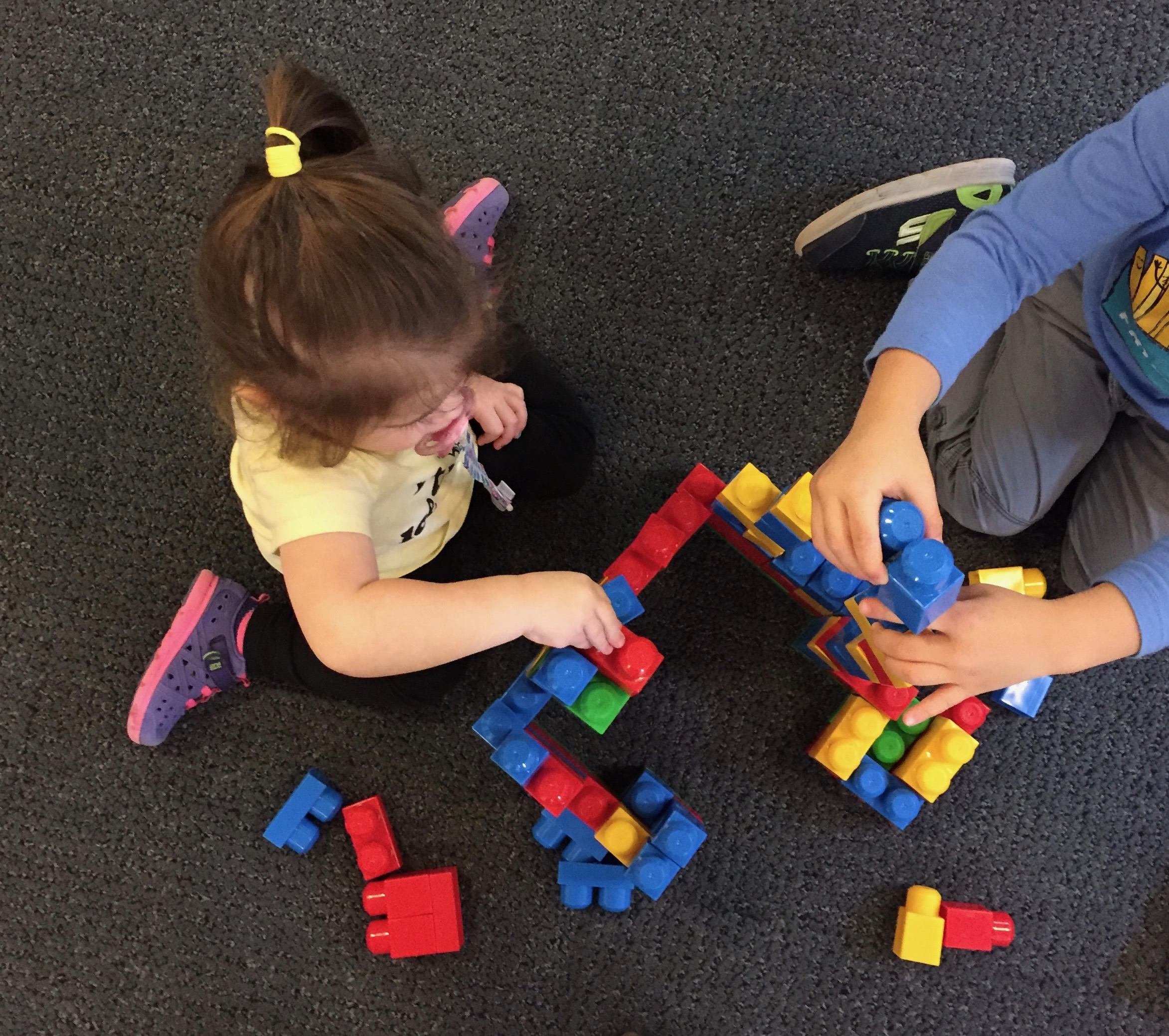Teach about science in the news in 2020
By Claire Reinburg
Posted on 2020-01-09
What do wildfires, drought, and extreme weather have in common? All these events in the news can be doorways to exploring weather, climate, and more with your students. NSTA’s Book Beat issue this month features lessons by NSTA Press authors that will help you teach timely topics your students may have on their minds at the start of this new year.
Wildfires and drought
News coverage of the bushfires in Australia raises questions about why and how wildfires spread and what might be done to combat them. Download the lesson “Wildfires” from Big Data, Small Devices: Investigating the Natural World Using Real-Time Data to help grade 3-12 students determine whether there is a correlation between drought and wildfires using data from online databases. Along the way, students explore the role of water in Earth’s surface processes and natural hazards while analyzing and interpreting data. For additional lessons related to climate change and data analysis, check out Understanding Climate Change, Grades 7–12.
Climate and location
Elementary students can learn about weather patterns and climate as well as how latitude affects climate during the lesson “Climate and Location: How Does the Climate Change as One Moves From the Equator Toward the Poles?” from Argument-Driven Inquiry in Third-Grade Science: Three-Dimensional Investigations.This lesson gives students the opportunity to describe and predict the patterns in the seasons of the year and then use their developing understanding of patterns to help them figure out how latitude affects climate. For more lessons like this related to Earth science, biology, and physical science, visit the Argument-Driven Inquiry series page to download sample lessons.
Understanding environmental impacts on species
Climate change threatens the survival of many species, especially those that overheat in higher temperatures. Help your students explore this current issue through “Triumph of the Pika: Understanding Environmental Impacts on Species,” a lesson about pikas (an animal related to rabbits) from the newly released book Discovery Engineering in Biology: Case Studies for Grades 6–12. This case-study lesson begins with a surprise discovery by scientists that a pika population survived a wildfire that destroyed an entire forest. Through examining this case, students will learn how we obtained valuable information about the pika’s survival, information that may help us protect wildlife in the face of climate change. Be sure to also check out the other book in this series, Discovery Engineering in Physical Science: Case Studies for Grades 6–12.
Celebrate the new year with 20 percent off these 20 new NSTA Press books
NSTA Press is offering 20% off our 20 newest books and e-books through January 31, 2020. Use promotion code NEW20 when ordering and visit our page that lists the eligible books you can choose from. Offer is valid on purchases made through the online Science Store and shipped to U.S. addresses and may not be combined with other offers. Find your next science-teaching resource and save.

What do wildfires, drought, and extreme weather have in common? All these events in the news can be doorways to exploring weather, climate, and more with your students. NSTA’s Book Beat issue this month features lessons by NSTA Press authors that will help you teach timely topics your students may have on their minds at the start of this new year.
Wildfires and drought
STEM For All Multiplex Launches by Joni Falk
By Kate Falk
Posted on 2020-01-09
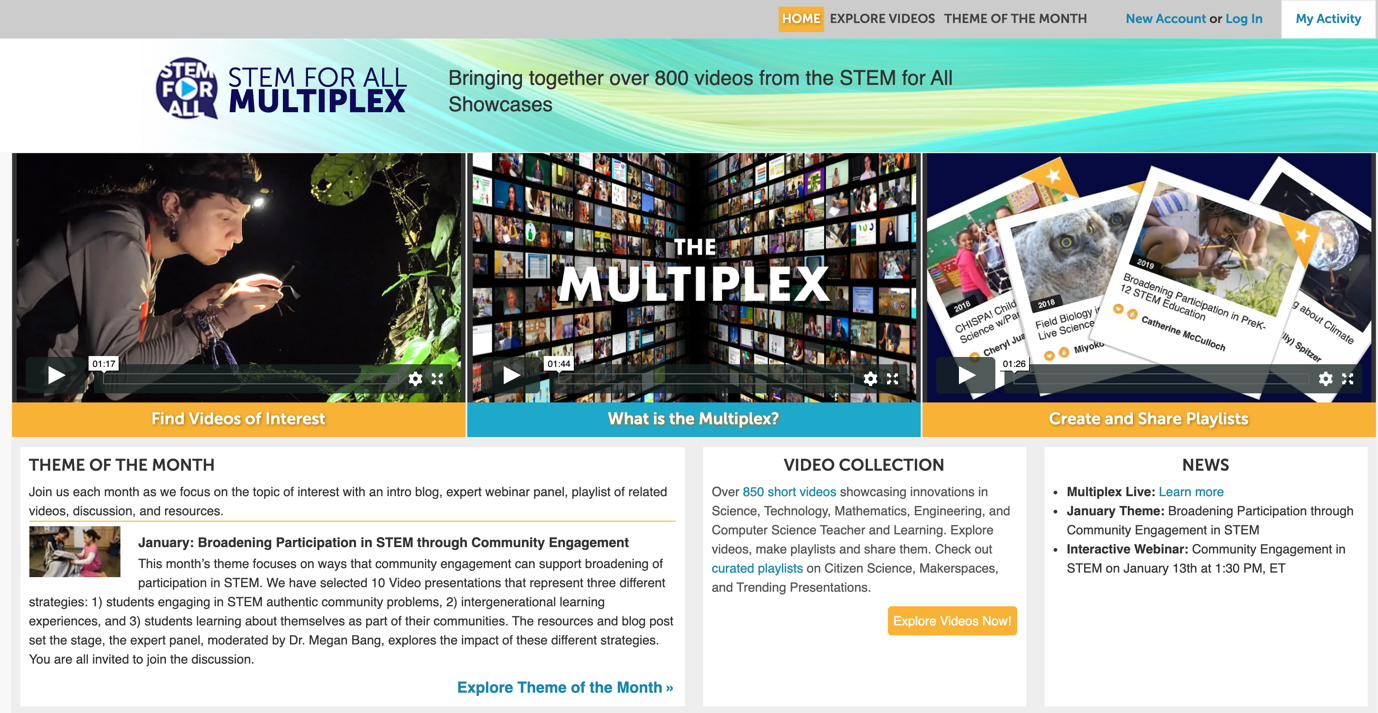
This new, interactive video platform will enable researchers, educators, and parents to access federally funded innovative programs aimed at improving STEM teaching and learning.
TERC is pleased to announce the launch of the STEM for All Multiplex, funded by the National Science Foundation (NSTA is a partner with The Multiplex).
This online, interactive platform features over 850 videos that showcase federally funded research and development projects aimed at transforming science, technology, engineering, mathematics and computer science education. These videos, first presented by researchers and developers at annual week-long STEM for All Video Showcase events, have now been aggregated in the Multiplex so that visitors can view, discuss, and share with colleagues year-round.
The Multiplex is an innovative, multimodal platform which shares cutting-edge research and development projects aimed at enhancing STEM education with multiple audiences around the globe. It disseminates NSF and other federally funded research, publicizes promising findings, stimulates discussion, and broadens participation in STEM. Researchers, educators, policy makers and parents can learn about cutting-edge efforts to improve STEM education. Videos span multiple disciplines and reflect efforts in pre-k through graduate education. They explore community initiatives, games and apps, and learning in formal and informal environments.
Through short 3-minute videos and related online discussions, the Multiplex will provide researchers, educators, policy makers, and the public with access to current curricula development efforts, innovative programs, and technical innovations aimed at improving STEM education. It provides a virtual meeting place for researchers and practitioners to share their perspectives.
While using this tool educators can become aware of federally funded STEM education research, programs, and resources which they can adapt, while also have the opportunity to provide feedback, and input, to researchers across the country.
The free membership to the Multiplex provides access to all videos as well as the ability to post a query, comment, or to offer feedback to the presenters. Each video presentation has its own interactive discussion and presenters are notified of new comments when they are posted. The discussions provide a way for researchers, educators, and the public at large to interact with each other.
Each member of the site can also create playlists. These can be playlists of favorites, videos pertaining to a particular theme, or those produced by an organization or University. Video playlists can be saved, edited, and shared with colleagues and friend through email, Twitter, or Facebook.
The site will host “Theme of the Month” events that will explore a topic in depth, and show multiple approaches taken by different research projects to address a common challenge. Each theme will include an introductory blog, an expert panel webinar, a curated video playlist, a month-long online asynchronous discussion, and a synthesis document summarizing lessons learned.
The first “Theme of the Month” will address “Broadening Participation through Community Engagement.”
All teachers are invited to join the site to learn more about the program, and to register for the expert panel webinar that will be held online on January 13 at 1:30 pm. Dr. Megan Bang, Vice President of the Spencer Foundation will moderate the first expert panel. Panelists will include well known researchers and community organizers who are engaged in creative projects that involve students in authentic problems of the community, create intergenerational learning experiences, and enable students to connect to their roots and community.
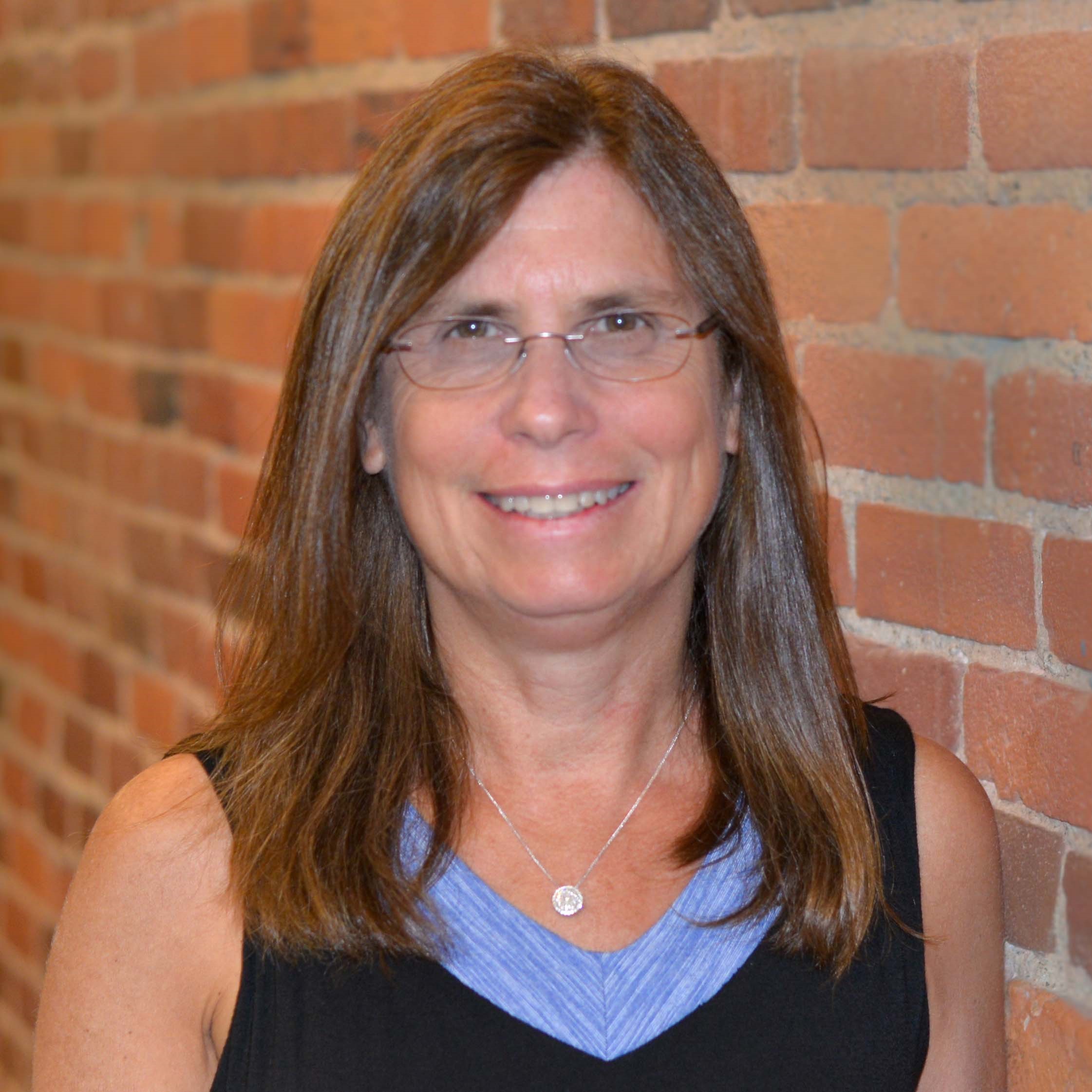 Joni Falk co-directs the Center for School Reform at TERC, a nonprofit research and development institution aimed at improving mathematics and science teaching and learning. She is the Principal Investigator of the STEM For All Video project.
Joni Falk co-directs the Center for School Reform at TERC, a nonprofit research and development institution aimed at improving mathematics and science teaching and learning. She is the Principal Investigator of the STEM For All Video project.

Legislative Update
Congress Passes Funding for FY20 Federal Programs
By Jodi Peterson
Posted on 2020-01-06
Prior to adjourning for the holidays Congress passed, and the President signed into law, the spending bill that funds the government for the remainder of fiscal 2020.
The bill largely rejects the Trump administration’s proposal to cut approximately $7 billion in education spending and eliminate 29 programs, including Title IVA and 21st Century Community Learning Centers. Instead it includes $72.8 billion in funding for the Department of Education, an increase of $1.3 billion compared to previous fiscal years.
Some good news for science and STEM education programs funded through ESSA; the bill provides:
- $2.1 billion for Title II Supporting Effective Instruction State grants, an increase of $76 million; this program provides much-needed funding for teacher professional learning.
- $1.2 billion for Title IV Student Support and Academic Enrichment Grants, a $40 million increase, which supports a wide range of activities including STEM programs and school safety activities.
- $1.3 billion for Career and Technical Education Grants, level with FY2019.
- 25 billion for 21stCentury Community Learning Centers to support academic enrichment activities for students before school, after school, and during the summer, an increase of $28 million.
- $65 million in dedicated STEM education funding within the Education Innovation and Research program, a $5 million increase, including a specific prioritization on computer science education.
In addition, the bill provides funding increases across the board for these programs:
- $16.3 billion for Title I Grants to Local Educational Agencies, an increase of $450 million.
- $13.6 billion for IDEA/Special Education grants to states, an increase of $410 million, including preschool grants and grants for infants and families.
- $1.5 billion for Impact Aid, an increase of $40 million.
- $$440 million for the Charter Schools Program, the same as the FY2019 enacted level, including a $5 million increase for grants to replicate and expand high-quality charter school models and a $5 million increase for charter school facility grants.
- $105 million for Safe Schools National Activities, an increase of $10 million, which supports evidence-based activities to improve school safety, prevent violence, and improve school climates.
The maximum Pell Grant award under the bill would be increased by $150, an increase of more than 2 percent from $6,195 to $6,345 for the 2020-21 school year.
More details on the bill can be found here.
STEM Bills at the State Level
Interested in what your state legislature is doing with science and STEM education? Check out this list from our colleagues at the STEM Education Coalition which contains every state-level STEM education bill that has been introduced, considered, or adopted in state legislatures over the past 4 years.
Education Freedom Scholarships in 2020?
Also before the holiday break, the White House convened a roundtable discussion to highlight state-based school choice programs and promote the administration’s Education Freedom Scholarships initiative.
This year the Administration hopes to jump start its proposal for a $5 billion federal tax credit for donations to scholarship-granting organizations to pay for students to attend private schools or expand their public education options. The bills in the House ( H.R. 1434 (116) and the Senate S. 634 (116) have seen no action and have little support from Democrats. Conservative groups, such as the Heritage Foundation, while praising the theory of school choice believe this type of bill “undermines conservative efforts to streamline the federal tax code.”
Stay tuned, and watch for more updates in future issues of NSTA Express.
Jodi Peterson is the Assistant Executive Director of Communication, Legislative & Public Affairs for the National Science Teachers Association (NSTA) and Chair of the STEM Education Coalition. Reach her via e-mail at jpeterson@nsta.org or via Twitter at @stemedadvocate.
The mission of NSTA is to promote excellence and innovation in science teaching and learning for all.
Prior to adjourning for the holidays Congress passed, and the President signed into law, the spending bill that funds the government for the remainder of fiscal 2020.
The bill largely rejects the Trump administration’s proposal to cut approximately $7 billion in education spending and eliminate 29 programs, including Title IVA and 21st Century Community Learning Centers. Instead it includes $72.8 billion in funding for the Department of Education, an increase of $1.3 billion compared to previous fiscal years.
Safety Blog
School Facility Safety/Security! (Part 1)
By Kenneth Roy
Posted on 2020-01-03
I. Unsecured School Facilities
School buildings can be a potentially dangerous place for teachers and students if safety and security are ignored. For example, science labs have potential biological, chemical and physical hazards which can be present health and safety risks. Only safety trained employees and students are to be allowed in science labs. Unsupervised occupants can be seriously injured putting the science teacher and school administration in legal jeopardy. Also be aware that given the inventory of hazardous materials, science labs can be the focus of intruders! In fact, Homeland Security has addressed this concern in a great resource titled “K-12 School Security Guide (2nd Edition) and School Security Survey.” It can be found at https://www.dhs.gov/publication/k-12-school-security-guide. The resource provides preventive and protective measures to address the threat of violence in schools.
II. Regulatory Standards
Employers are charged by the Occupational Safety and Health Administration’s (OSHA’s) mission is to ensure that employees work in a safer and healthful environment by setting and enforcing standards. This is fostered by providing training, outreach, education and assistance. Employers must comply with all applicable OSHA standards. They must also comply with the General Duty Clause of the OSH Act, which requires employers to keep their workplace free of serious recognized hazards. (https://www.osha.gov/laws-regs/oshact/section5-duties) This includes security issues.
The science teachers and supervisors/administrators need to work in concert in attempting to provide for a safer and secure teaching/learning environment for students, faculty and administrators.
III. Raising Security Levels
A safer and secure science laboratory begins with building or facility security needs which must be addressed. This is the first “line of defense.” These simple recommended procedures will not guarantee a 100% secure workplace. However, they will raise everyone’s level of awareness and help the building become more secure and safer – both physically and psychologically! Important recommended procedures include:
A. Designated Reception Area – The building should have a designated entrance and receptionist area to control access. All remaining entrance doors should be locked.
B. Visitors – Once signed in, visitors should be escorted to designated work areas by employees.
C. Employees – All employees should wear employee photo identification.
D. Strangers – Employees should challenge any unaccompanied stranger(s) in the workplace.
E. Mail – Employees should be trained and be provided with personal protective equipment (e.g., latex or vinyl gloves) to sort mail. Protocols should be in place to deal with suspicious items.
F. Lockdown/Evacuation Procedures – Employers should develop and have posted both lockdown and evacuation procedures for employees and students. All science laboratories, preparation rooms and storerooms should have communication access in cases of emergency. Appropriate drills should be exercised.
G. Science Laboratory Access – All access doors to laboratories are to remain closed and locked when unoccupied. Only certified science teachers, administrators, and facilities maintainers/custodians should have special keys to laboratories, storerooms and preparation rooms.
IV. Planning
Employers should establish effective safety and health management systems and prepare their workers to handle emergencies before they arise. For example, OSHA requires emergency preparedness plans for employees in its 29 CFR Part 1010.30 and 29 CFR Part 1910.165 standards (Available at www.OSHA.gov). These standards mandate that employers provide emergency action plans and fire prevention plans. These plans are only an example of proactive preparation.
OSHA’s Fact Sheet titled “Planning and Responding to Workplace Emergencies” (https://www.osha.gov/OshDoc/data_General_Facts/factsheet-workplaceevergencies.html) provides emergency procedures, including the handling of any toxic chemicals. They should include:
A. Escape procedures and escape route assignments.
B. Special procedures for employees who perform or shut down critical plant
operations.
C. Systems to account for all employees after evacuation and for information
about the plan.
D. Rescue and medical duties for employees who perform them.
E. Means for reporting fires and other emergencies.
Also check with state and local government departments for additional safety/security incident planning procedures.
V. Final Note
Remember – “AAA” – Awareness, Assessment and Action are keys to addressing safety and security – be prepared!
Submit questions regarding safety to Ken Roy at safersci@gmail.com or leave him a comment below. Follow Ken Roy on Twitter: @drroysafersci.
NSTA safety blog: /2016/06/13/welcome-to-the-nsta-safety-blog/
NSTA resources and safety issue papers: https://www.nsta.org/safety/
Join NSTA
Follow NSTA
I. Unsecured School Facilities
Inspiring Young Geoscientists With Fossils
By Debra Shapiro
Posted on 2020-01-02
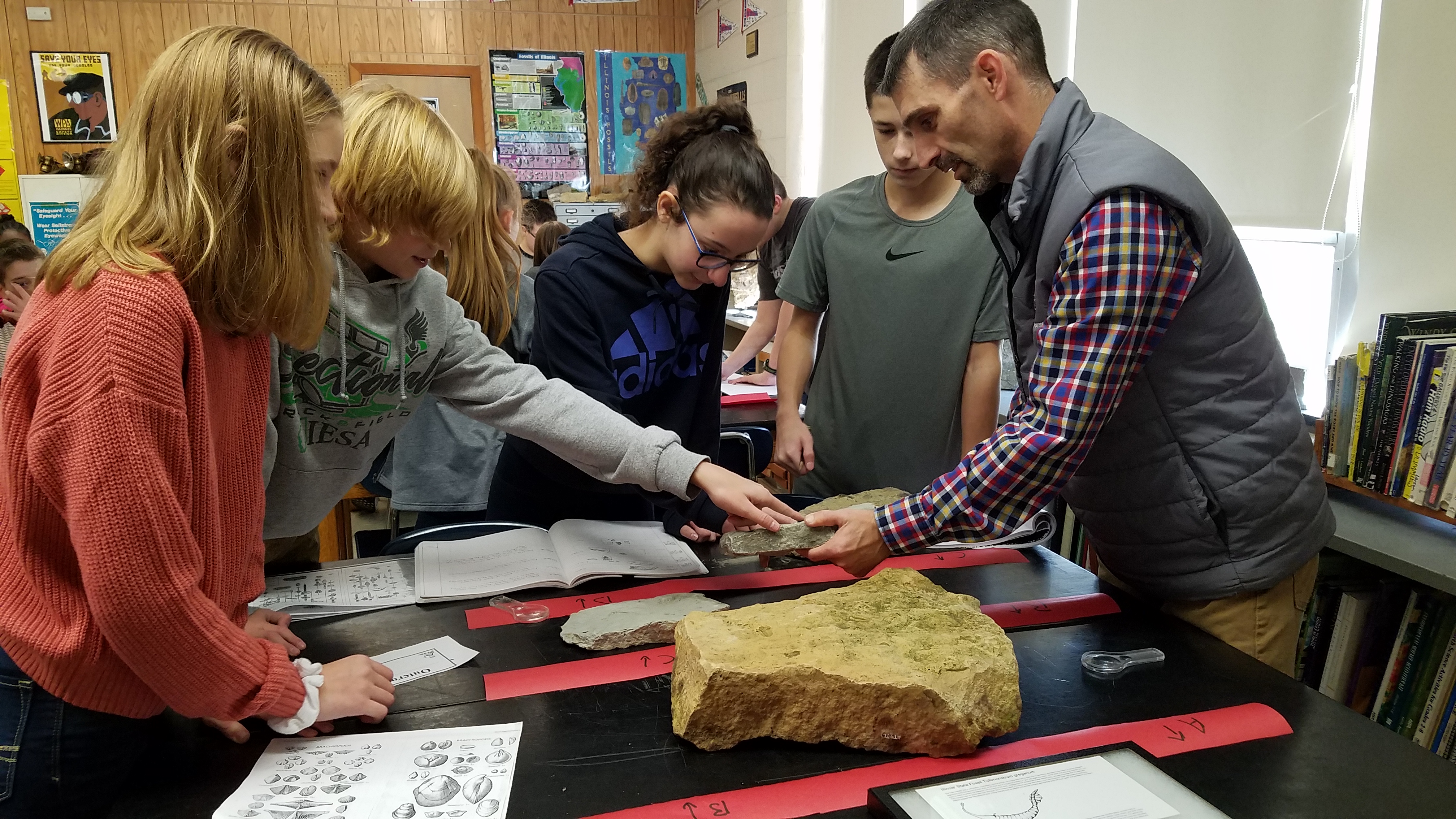
“I have an extensive fossil collection that we use in my eighth-grade science classes. We use it in our investigations of Earth history, in particular the Midwest,” reports Troy Simpson of Glenn Raymond School in Watseka, Illinois. He says he uses fossils “not only for investigating how life evolves and develops, but [also] for paleoenvironmental changes, simulated geologic strata interpretation, piecing together the geologic history of our region. I believe…getting the specimens in the hands of the students…helps make it more relevant to them…Even if you have [only] a few samples, it can impact students’ learning.
“I like to use larger specimens that show fossils in their environmental and geological context. This helps with the student interpretation of the geologic past,” Simpson observes. “The Midwest used to be an ocean and a tropical forest; we have evidence of this.
“My mission is [this]: We need more geoscientists,” Simpson asserts. “Unfortunately, geoscience [has] become a fossil science in and of itself. It is a vicious cycle [in which] fewer students are introduced to it at the K–12 level, thus fewer college students go into it, then numbers drop, and programs become downsized. Looking down the road, we will need those geoscientists to help with investigations on Earth and on other celestial bodies
as well.”
DeLacy Humbert, a science teacher at Capital High School in Helena, Montana, would agree. She acquired funding from science-based grants that allowed her to create a high school class on paleontology. “Everyone loves dinosaurs, but after third or fourth grade, [the enthusiasm] dies down. That’s a detriment to STEM [science, technology, engineering, and math because] dinosaurs are a ‘gateway science drug,’” she explains. “I saw the need. In paleontology units in Earth science class, the students loved it.”
Humbert says she “dreamed of this class for years. It took two years to get everything ready and propose it” to all of the department heads and the principal, then to the school board. She had to create her own curriculum and resources because “nothing between [the] elementary [level] and [the] college [level] existed.”
Humbert first taught the class in the 2018–2019 school year. “We had 30 students and a waiting list. There were a few less students this year, but we still had a waiting list,” she notes.
After the first year, Humbert tweaked the course. “Last year, we did a pigeon dissection before lunch. It was gross, and pigeons are expensive,” she admits. This year, she is using rotisserie chickens, which are much less expensive. “Bone structure is important,” she maintains.
Humbert also leads a summer camp that features a dinosaur dig. To prepare the students, she shared fossils from her collection and revealed their age, then had the students identify them. “It takes a while for them to identify [the fossils]. They need practice,” she contends.
The dig was challenging, she says, because “I have to teach [students] how to excavate and prospect. Prospecting is hard because the terrain isn’t easy. [There’s the] dangers of falls, snakes, and wild cows.” Students’ parents had to sign waivers and provide health insurance, she notes.
Last summer, she and her students found a couple of dinosaurs. “I teach them how to prepare the fossils so they will be able to do internships at university labs,” she reports.
Michael Baldwin, IB Biology and IB Chemistry teacher at Brent International School in the Philippines, has his students do several activities to learn about fossils. For one, he says, “I find diagrams of articulated fossil vertebrates from different time periods, project them onto a surface, and draw and cut out the bones on card stock as close to actual size as possible. I then mix the ‘bones’ in a plastic bag, and I have students try to reconstruct the animal. From their reconstruction, you can have them draw what they think the animal looked like; you can give them real index fossils along with their skeleton so that they have to try [to] identify when the animal lived. They can look for evidence of what the animal ate and how it moved, etc. You can also have students use similar puzzles to compare homologous structures, etc.”
In another activity, says Baldwin, “Students can look at photos of fossil leaves and count stomata to compare to living plants to investigate possible levels of carbon dioxide in a discussion of the effects of carbon dioxide concentration and global warming on plants. Is there evidence that there was a high level of carbon dioxide as indicated by the number of plant stomata on similar species of plants from the Eocine [epoch]?” He has also “had students do experiments to test different hypotheses about the function of gastroliths [rocks held inside a gastrointestinal tract] in plesiosaurs.”
Teaching about the fossil record and how it’s changed over time gives her eighth graders “a piece of evidence to show how species changed over time,” and helps them construct a scientific explanation using geological rock strata, says Tanya Gordon, Earth science teacher at West Junior High School in Boise, Idaho. “My colleague and I have students do an activity to address that as part of a quarter performance task.”
Sue Meggers, middle school science instructor at Interstate 35 School in Truro, Iowa, points out that fossils are not only evidence of life, but also “evidence of nutrients, especially in typical marine deposits (limestone, potash, and phosphorus are mined from marine deposits and used as nutrient supplements or pH balancers in soils). And there’s an economic connection to fossils; for example, limestone is used in building.”
All of the teachers agree that letting students do their own fossil identification is essential to three-dimensional learning. “I brief them first, then give them the resources to do it, but they have to figure it out,” Meggers maintains.
Even young children can benefit from exploring fossils, says Sarah Erdman, lead teacher at FB Meekins Cooperative Preschool in Vienna, Virginia, whose collection includes “some mud tracks, fossils plus the environment they’re in, which helps students connect with what fossils are.” She adds, “We’ve been lucky to have people bring in their personal collections—for example, a paleontologist who visited my class…With students this age, we expose them to what we learn [from fossils] and who does the finding, [which is someone’s] job. [We tell students,] ‘That’s so-and-so’s mom who also [finds and studies fossils].’” At age three, children become aware of gender roles, “so it’s great to counteract that [by saying,] ‘This is an everybody thing.’”
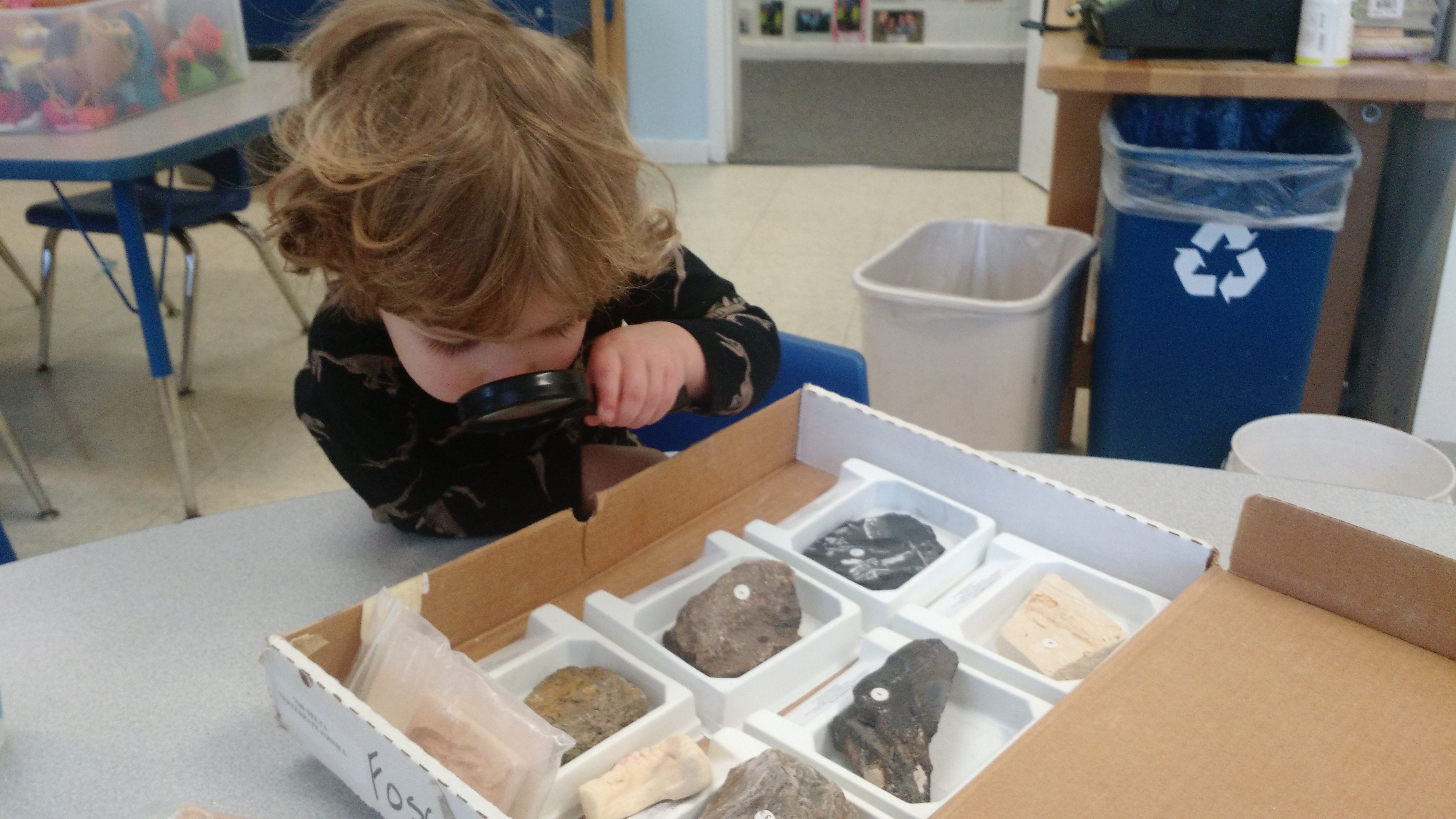
Finding, Handling, and Storing Fossils
Simpson connects with local quarry managers who help him find fossils. He also gets them from contacts from the National Earth Science Teachers Association and the Geological Society of America. And he takes his students to accessible outcrops and parks where collecting is permissible to gather rocks and fossils: “My students and I can go on-site and learn on the spot [about] the geology of the area and its fossils,” he relates.
In her rural area, “we live on Devonian to Pennsylvanian bedrock, so we collect fossils in our gravel,” reports Meggers. “My students don’t think of their environment as very cool or unique. Then they discover that their driveway has fossils. It blows their minds!”
“I was very fortunate to receive some lovely fossils from a member of our local rock club,” says Marteen Nolan, science teacher at Crocker High School in Crocker, Missouri. Among them was a fossil bed that intrigued students in her advanced geology class, so they contacted a University of Missouri-Columbia geology professor for assistance in identifying the fossils. “The students were able to determine that what they had thought was a [dinosaur] bone was in fact a different type of mud, and the fossil bed was likely from an ancient oyster bed that had been washed inland by a hurricane. It was such a great authentic scientific inquiry experience for them,” Nolan relates.
“Our state mining trade industry does a summer workshop,” she notes. “If mining takes place in your state, check with a mining agency” about fossil donations, she advises. Nolan also offers some safety precautions: “Obsidian glass is a volcanic glass with sharp edges…Don’t bring in asbestos! Gypsum can have it, too, so don’t let students hold it.”
One consideration for teachers is fossil storage. “Storage depends on how rare the fossil is and its condition. Some fossils can only be looked at. Thing is though, if you use them, then eventually they may be broken,” Baldwin cautions.
“I’m encouraging students to touch all of the fossils except carbon films because they’re so fragile,” says Gordon, who has found carbon films with impressions of fish fossils. She suggests that experienced teachers share their fossil collections with new teachers. “It would be beneficial for new teachers to have a way to build a collection…Foster that new enthusiasm for teaching with the ability to share things hands-on with students.”
This article originally appeared in the January 2020 issue of NSTA Reports, the member newspaper of the National Science Teaching Association. Each month, NSTA members receive NSTA Reports, featuring news on science education, the association, and more. Not a member? Learn how NSTA can help you become the best teacher of science you can be.

“I have an extensive fossil collection that we use in my eighth-grade science classes.
Book clubs, professional learning communities, and resources on equity
By Peggy Ashbrook
Posted on 2020-01-01
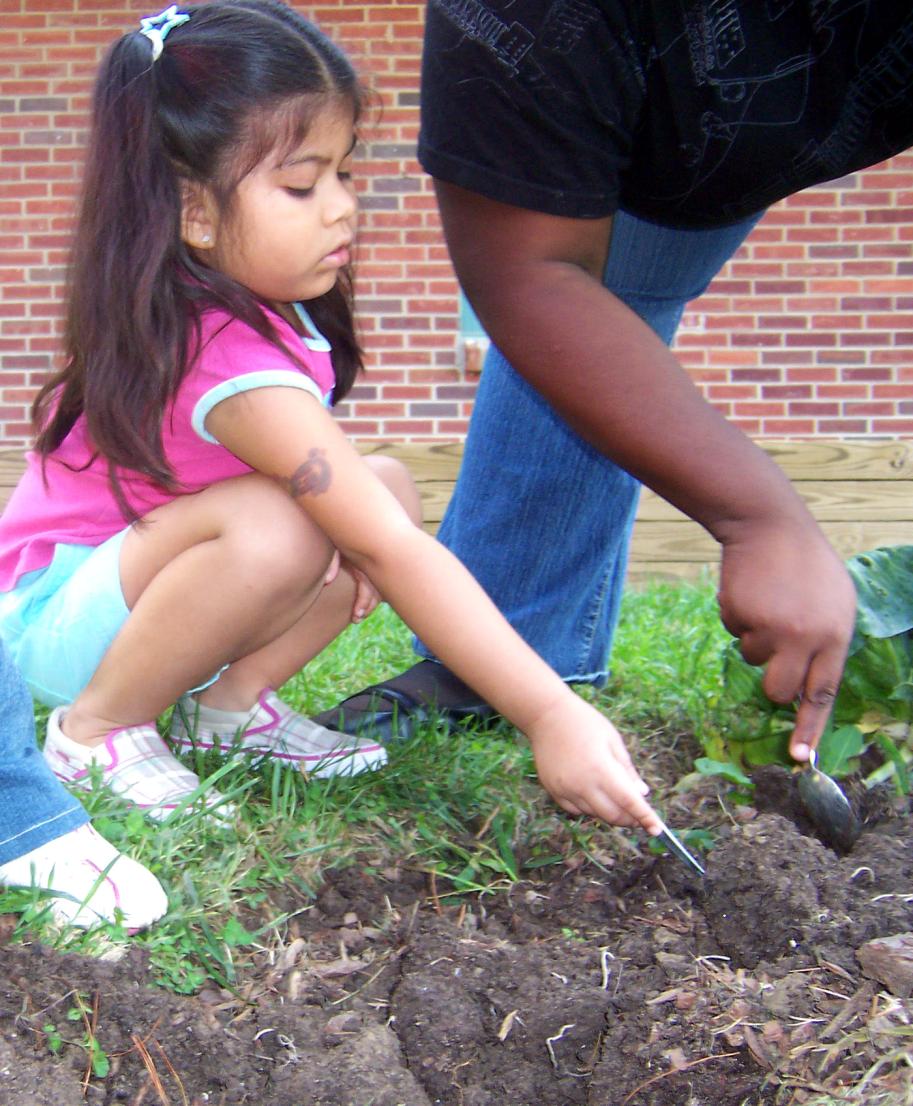
One of my favorite professional learning opportunities was an informal Professional Learning Community (PLC) organized by a colleague before the term “PLC” came into common usage. A small group of early childhood educators met weekly for about 8 weeks to discuss the wonderful book, Worms, Shadows, and Whirlpoolsby Sharon Grollman and Karen Worth, and share how we implemented the authors’ guidance in our own classrooms.
As the facilitator of the group I read the book more thoroughly than I had the first time so I would be well prepared to lead a discussion—cover-to-cover instead of skipping some sections. Reading the book with intent to discuss and share insights and argue with some ideas made me work harder to place the book in context of my own teaching.
The book Anti-bias Education for Young Children and Ourselves by Louise Derman-Sparks and Julie Olsen Edwards was the basis for another, virtual, book club, also formed with the goal of helping educators change our teaching practices. The leaders of the NAEYC Diversity and Equity Education for Adults Interest Forum created a supportive community where each of us could step up to lead a discussion. The support gained by hearing the experiences and advice of other educators really broadened my sense of how responsible I was for helping children reduce feelings of bias, and learn to value themselves and all community members. Resources we used to inform ourselves and update our library shelves included Teaching for Change’s booklists.
Since that book club, the NAEYC has issued a new position statement “Advancing Equity in Early Childhood Education” (in English and Spanish) grounded in NAEYC’s core values that emphasize diversity and inclusion and that respect the dignity and worth of each individual.
NSTA’s newly revised Gender Equity in Science Education position statement (November 2019) has specific recommended actions that can guide our teaching. The association reviews, revises, and updates position statements, displaying one of the best aspects of science education—continually seeking new understandings.
The statement begins with: “The National Science Teaching Association (NSTA) strongly asserts that gender equity is critical to the advancement of science and to the achievement of global scientific literacy. Gender equity means ensuring all students of any sex, gender identity and/or expression, or sexual orientation—regardless of racial or ethnic background or ability—are empowered, challenged, supported, and provided full access to become successful science learners.”
I want all children to develop their science identity, and know that everyone has the ability to act like a scientist in their daily life. Using questions and goals from the STEM Teaching Tools’ Practice Brief 15: Overview: How can we promote equity in science education?, I’m looking forward to reflecting on and growing my teaching practice in 2020:
- Implement instructional strategies to make science learning experiences more inclusive for all students.
- Integrate a focus on equity and social justice into every teacher learning experience in relevant ways—and not treat diversity as a segregated topic.
- Relate the scientific phenomena I teach and the concepts I want children to understand to the interests and practices of my students’ lives and communities.

One of my favorite professional learning opportunities was an informal Professional Learning Community (PLC) organized by a colleague before the term “PLC” came into common usage.
Developing Risk-Taking Students
By Sharon Delesbore
Posted on 2019-12-31
I want my students to “take risks” when learning but I am not sure how to start.
Alicia, Mississippi
We must deliver science content differently by modeling for our students that risk-taking is encouraged in the classroom. You can encourage risk-taking through differentiation. Think about three components that I call the “C.I.A. of Differentiation:” Content, Investigation and Assessment. As the teacher, you are the “director” of learning (pun intended). It is your mission to provide a learning environment in which students take an active part in the learning process. This means that you have to make teaching and learning not only engaging for them but for you too. Rethink your role as the teacher. You are not expected to know everything; however, you are expected to establish a safe learning environment where mistakes are permitted if students learn from them. Your content knowledge is important but it can be just as important for you to model the strategies you use when you do not know an answer. As you guide students to the information they need, they pose questions. Allow students to investigate, gathering information that will help them solve problems or validate established theories. Student products or assessments are concrete evidence of the learning that has taken place. Allowing students to demonstrate their knowledge through a choice of blogs, news reports, debates or posters keeps your classroom creative and relevant. Students feel safe to express themselves without judgment when they have choice. Bringing the “C.I.A.” to your classroom is risky but worth it. With this mindset, you develop skilled, science-conscious scholars willing to question ideas and design answers to help make a better place to live.
I want my students to “take risks” when learning but I am not sure how to start.
Alicia, Mississippi
Building Student Ownership
By Sharon Delesbore
Posted on 2019-12-31
I teach advanced science courses. Many of my students see school as a competition so they just want the correct answers to study for a good grade. How do I help build student ownership for learning in my science classroom?
–Chelia, Louisiana
Student ownership of learning is a paradigm shift for the teacher as well as the student. We develop this shift by preparing lessons with the end in mind. We must ask ourselves, “What do I want my students to learn from this unit?” As we plan with a conceptual mindset, our instructional strategies and activities must align with this thought process. Instead of fill-in-the-blank notes and worksheets, we plan for students to do more meaningful and creative tasks that will engage them in the content as we facilitate their learning.
Building scientific content knowledge is important and learning appropriate terminology is crucial so graphic organizers—such as the Frayer Model in which students write a word’s definition, restate in their own words, draw a picture, then give an example of its usage—makes the students responsible for comprehension. We must ask our students, “What are you learning?” instead of “What are you doing?” Posting, “What am I learning and how does it apply to me?” in your classroom is a fundamental reminder for both educators and students. As teachers, we must plan opportunities for students to process and apply knowledge, not simply recite or regurgitate information. Yes, science is innately an active subject, but most importantly, science is a way of thinking where we ask questions, gather information to make informed decisions, and apply our knowledge toward the betterment of our society.
I teach advanced science courses. Many of my students see school as a competition so they just want the correct answers to study for a good grade. How do I help build student ownership for learning in my science classroom?
–Chelia, Louisiana
Plan Labs with Assessments, School Calendars in Mind
By Sharon Delesbore
Posted on 2019-12-26
I have written a lab about quarks. The problem is there are no Next Generation Science Standards (NGSS) about quarks. The only standards that refer to the nucleus is about protons and neutrons. How can I align my lab with standards that don’t exist?
—Gary, Illinois
This is a great question which leads to the purpose of performance expectations (What are students to learn?) for states that have adopted NGSS and other states using their own state science standards. In either case, students will have a comprehensive assessment and it is important that we, as teachers, follow a trifecta of alignment with 1.) performance expectations, 2.) instructional delivery and 3.) assessment. I’m sure you designed a great lab on quarks and I would never negate your hard work and time, but if there is no performance expectation written, then I suggest you hold off on scheduling the lab. You are ultimately charged with preparing your students for successful understanding of the performance expectations. Instructional time is sacred. Whether your students are assessed by an end of course exam, semester final, or other performance task, you want your students ready.
To help keep focused on that goal, try planning backwards: Find out when your culminating assessment is scheduled. Then think about your school calendar. When are your formative and summative assessments? When do your terms end? What days do you know that little instruction will happen due to assemblies or school-wide events? Include these dates on your teaching calendar to help map out the time you have to teach all of the significant performance expectations within your designed units of study. Planning is key!
I have written a lab about quarks. The problem is there are no Next Generation Science Standards (NGSS) about quarks. The only standards that refer to the nucleus is about protons and neutrons. How can I align my lab with standards that don’t exist?
—Gary, Illinois
Connecting with Students
By Sharon Delesbore
Posted on 2019-12-24
I’m a first-year high school science teacher seeking desperately the best way to connect with my freshman biology students who are very smart but are not use to being pushed to comprehend a rigorous curriculum. Any suggestions would be greatly appreciated.
—Chelsea, Texas
The 5E model of science instruction is based on the following components: 1.) Engage, 2.) Explore, 3.) Explain, 4.) Elaborate and 5.) Evaluate. As you build upon your pedagogy, I suggest you first emphasize the engage part of the 5 E. This component is a good starting point because it helps students learn to ask questions and not assume every answer will be handed to them. This “microwave generation” wants answers now but if we do not challenge them to ponder the “what ifs” of life, then our students will not develop into young scholars able to innovate and create—making life more effective, efficient, economical, and interesting.
Engaging them with a question or asking them to work in a group to develop a graphic organizer can generate thoughts of what they already know, what they would like to know, and how they know they understand the concept, which also sparks interest and helps students to think in terms of how this applies to “me” and our world. Engagement leads to exploration that facilitates application. Engaged thoughts should lead students to define specific questions they are curious to answer. Gaining knowledge for themselves will develop their own explanation of phenomena that we, as science teachers, can elaborate on. We can clarify misconceptions, fill gaps of information and finally help them evaluate ways to make society better.
I’m a first-year high school science teacher seeking desperately the best way to connect with my freshman biology students who are very smart but are not use to being pushed to comprehend a rigorous curriculum. Any suggestions would be greatly appreciated.
—Chelsea, Texas



